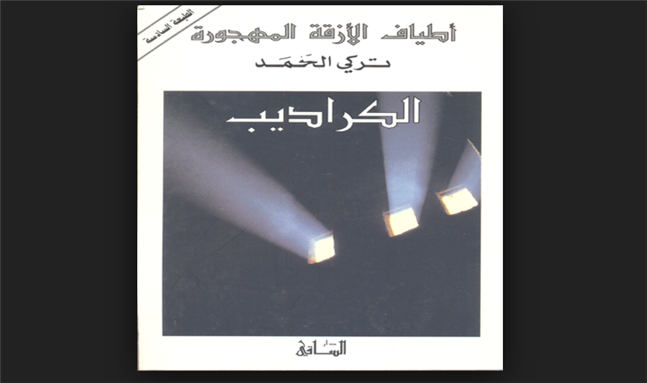How to Do Things with Hair
Curated by Barrak Alzaid
thejamjar, Dubai, UAE
26 October—2 December, 2013
Curator Barrak Alzaid has been critically grappling with hair—men’s body hair, to be more precise—for years now. “I find men’s body hair compelling, and as I did studio visits over the last four years, I began to log the variety of ways in which men’s body hair, or accessories of men’s body hair, were deployed.” Alzaid recently translated this ongoing professional and personal engagement into an exhibition hosted by Dubai creative space thejamjar. He presented works by six artists that creatively confront some of the ways in which “hair” has been approached in various socio-cultural contexts. These works, at different times and in varying ways, have prompted Alzaid to question his perception and treatment of this bodily feature, and to reflect on the role it has played in shaping his relationship with his own body and that of others.
“This show emerged out of the unconscious links I began to make between the works,” Alzaid tells me, “the way in which each piece tells a story about the artist and their experience of themselves; the encounter such explicit work shapes with the audience; and observations about our social relationships in the broader world.”
Curators are often portrayed as authorities whose purpose it is to communicate the “meaning” of a given art work or the collective significance of an artistic assemblage to an audience. An exhibition is rarely advertised as a product of curatorial experiences or specific questions and issues that continue to concern curators. Rarely do we find a poetic piecing together of works to create a narrative that is, in turn, open to multiple reinterpretations. “Artists are generally permitted to be extremely raw in their work and in the presentation of themselves in their work,” Alzaid reflects, “but curators and those who write about art are expected to package themselves as a viewer or interlocutor, as opposed to a body with emotions and something at stake.”
In his curatorial framing of How to Do Things with Hair, Alzaid highlights the thematic and theoretical backbone behind each of the works, explaining as well what brought him to value them as independent, thought-provoking pieces, each of which “does” something unconventional with hair. However, he does not attempt to assign the exhibition a unifying “meaning” in order to forcefully mash and merge its distinct works into one blended, monochrome perspective on hair and its sociocultural inferences. The works, he writes in his brief curatorial statement, “dismantle hair from its primary meaning and recontextualize it.” What that “primary meaning” is and how the works challenge and reevaluate it are intentionally not elaborated upon, leaving the viewer to interpret meaning and context:
I wanted the works in the show to unsettle the viewer’s understanding and expectations of their own bodies, the body hair of others and what such aspects of the body signify for the person and the context they are in. My intention in leaving it vague was to invite the audience to make that inquiry for themselves.
As a curator, Alzaid offers his audience the freedom to interact with the displayed works on their own terms, free of the need to match their varied experiences to a static prefatory wall or catalogue text, wasting their time frantically searching for the link that binds the various works into one comprehensible whole.
The exhibition was located in what felt like a corridor of the already small jamjar gallery. Grouping them together in such a limited space, however, allowed the works to have a more immediate visceral impact. Images of hair dove off the crisp white walls right into the imagination, activating and disrupting a flurry of associations that come to mind when confronted with this universally recognizable feature, which is presented here in a variety of bizarre ways.
Upon entering, my gaze scraped the surface of the glass protecting Monira Al-Qadiri’s sleeping sculpture Dreamer, as I was drawn to Lebanese artist Raed Yassin’s Self Portraits with Foreign Fruits and Vegetables. I was mesmerized, not by the hairy, shirtless bald man pictured before me, but by the vegetable accessories he nonchalantly wore in his mouth and around his neck. Time and again, my eyes would sneak back to the stalk of broccoli between his lips or the ring of mushrooms hiding his shoulder fuzz, gradually realizing how peculiar Yassin had made something as banal as an everyday vegetable. By divorcing a mushroom from what one deems to be its “usual” context, he had transformed it into something strange, absurd, and therefore unsettling. Yassin’s work highlights the precariousness of our notion of what is ordinary, emphasizing that it is a sensation we must cultivate.
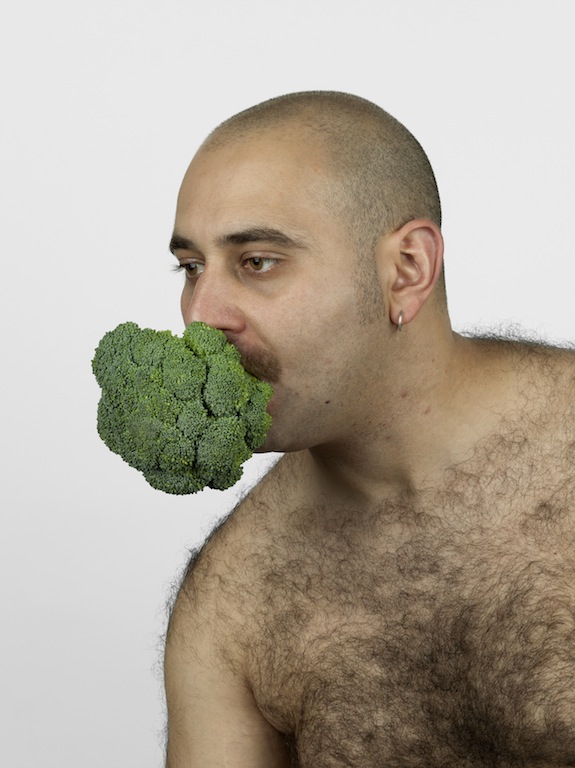 [Raed Yassin, Self Portraits with Foreign Fruits and Vegetables, 40 (2011). Image copyright the artist.]
[Raed Yassin, Self Portraits with Foreign Fruits and Vegetables, 40 (2011). Image copyright the artist.]
The longer I stared, the more I began to question my assumptions about the male body on display alongside the edibles. The bodies of men, like those of women, are subject to the demands of a given sociocultural moment; they are also asked to perform certain hegemonic understandings of gender and sexuality, to adhere to a constructed notion of “normal” masculinity. By disrupting our sense of what is familiar and ordinary through his play with vegetables, Yassin pushes us to think critically about how we came to our conclusions regarding what constitutes acceptable male behavior, to question the association of hair with masculinity, and to trace how we arrived at our understanding of what is “masculine” in the first place.
My own personal feelings about male body hair, of which I was not totally aware before this exhibition, faced with Yassin’s figure, seemed to float up to the surface, their fragility suddenly visible, making them vulnerable to scrutiny. To elaborate on what these particular assumptions were and how Yassin’s work challenged them is not something I necessarily can or should do. Alzaid, after all, designed an exhibition that was meant to engage viewers differently depending on their particular experiences and subjectivities, so to delve too deeply into the roots of my reaction to Yassin’s portraits might undermine the entire curatorial premise, imposing my subjective interpretation onto the art work.
Kuwaiti artist Dalal Ani’s digital prints Threading 1, Threading 2, and Women’s Circle harbor a potential similar to that of Yassin’s portraits. They center around the ‘agal, the ring-like accessory that holds in place the cloth ghutra men in the Gulf wear over their heads. For her installation, the artist unbraided the tight cord and created a frightening full-body garment out of it. She then wore this garment to a salon, where she documented herself undergoing the painful process of facial hair threading. Looking over this discomforting piece, I thought about how often I, as a Middle Eastern woman, have critiqued the agonizing and rather humiliating beautification processes I am asked to undergo in order to be received as conventionally desirable; about how often I have reacted in indignation to the many demands made on how I should dress and carry my body. Observing the ‘agal made foreign in its unraveling, however, I realized how rarely my thoughts drifted towards the male body—how I had long angrily contemplated the way men imposed their ideas of what a woman was and should be on me, but how I all too rarely meditated on what society asked of them and their bodies. How often, I thought, do we speak of the veil, and how rarely do we engage with the many ways in which men are asked to cover and reveal, with all the “requirements” of normative masculinity?
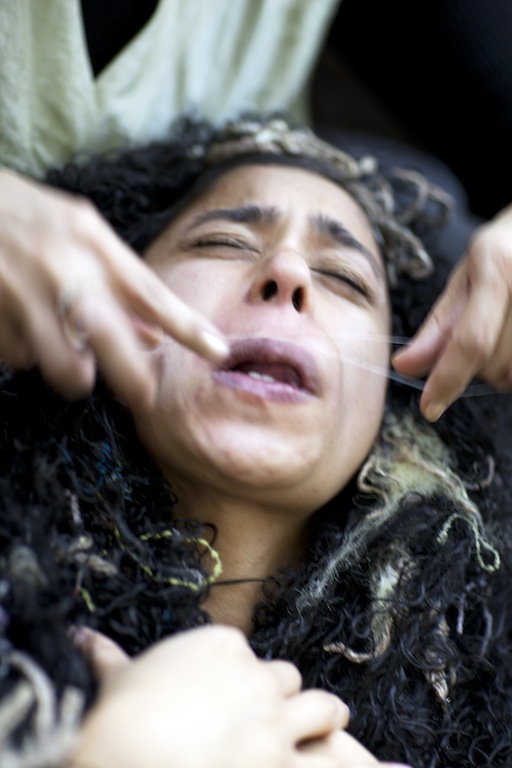 [Dalal Ani, Threading 2 (2012). Image copyright the artist.]
[Dalal Ani, Threading 2 (2012). Image copyright the artist.]
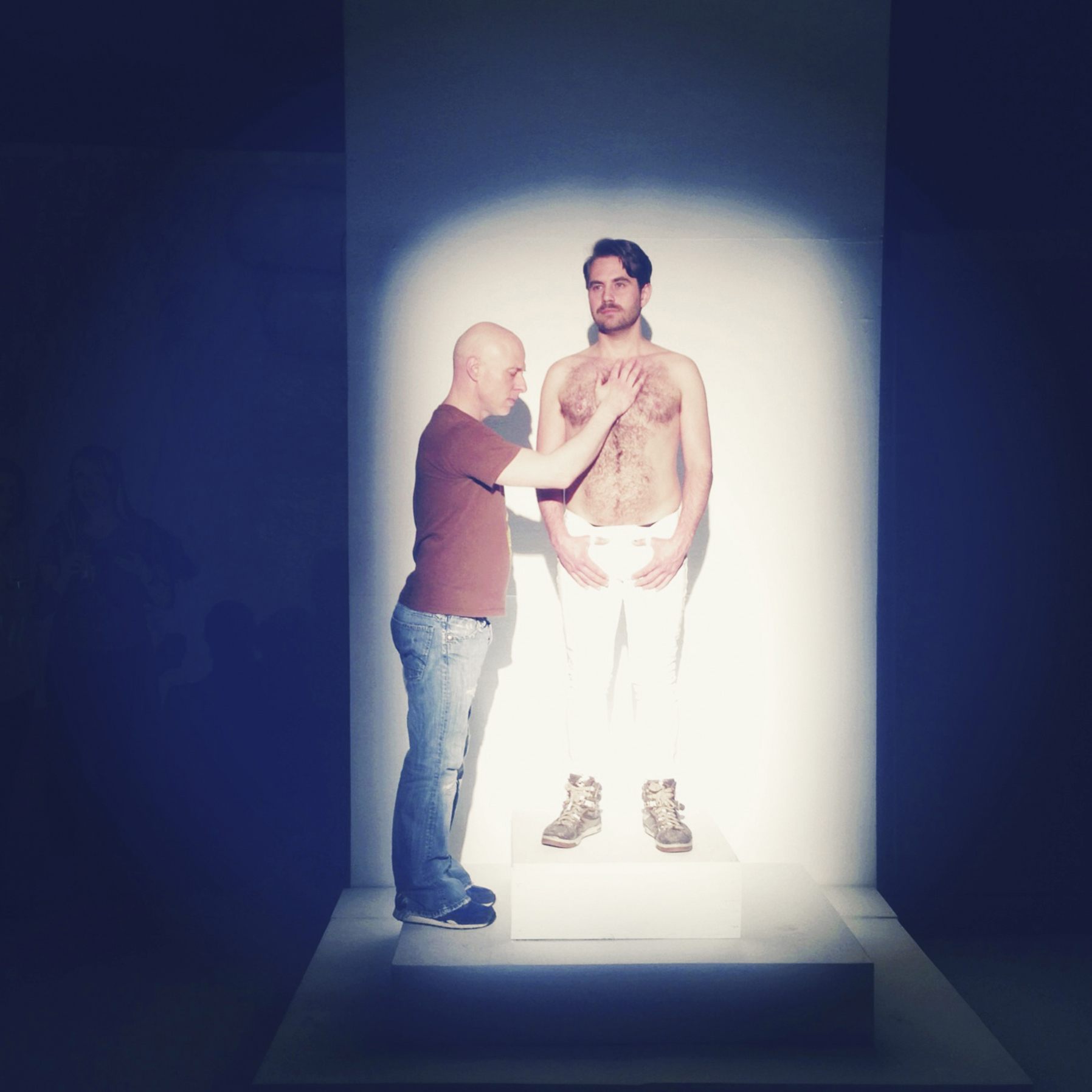 [Sean Fader, #wishingpelt instagram image 42 (2013). Image copyright the artist.]
[Sean Fader, #wishingpelt instagram image 42 (2013). Image copyright the artist.]
These thoughts continued to race through my mind as my eyes settled on the delicate flower nestled within a literal body of chest hair in Iranian artists Rokni and Ramin Haerizadeh’s digital prints Recovering, and later as they widened in partial fear at the sight of the white plaster cast replica of Kuwaiti artist Monira Al Qadiri’s face wrapped in a long sheep’s wool beard for Dreamer. At the end of my round, I found myself in front of a panel of photographs documenting American artist Sean Fader’s experimental performance piece #wishingpelt. Men and women (and specifically sailors) were shown fondling the bare-chested artist’s body hair. They were told to make a wish while caressing him; their experiences were then captured on their smart phones, and they were encouraged to circulate the images online, initiating a public, collective exploration of the ways in which we can maintain a semblance of intimacy in our hyper-documented world. This process achieved a kind of harmonic balance through the juxtaposition of the private wishes and the public photos. #wishingpelt was shown alongside the thirty-minute video installation Pelt, a lengthened version of a two-minute-long chest hair grooming session.
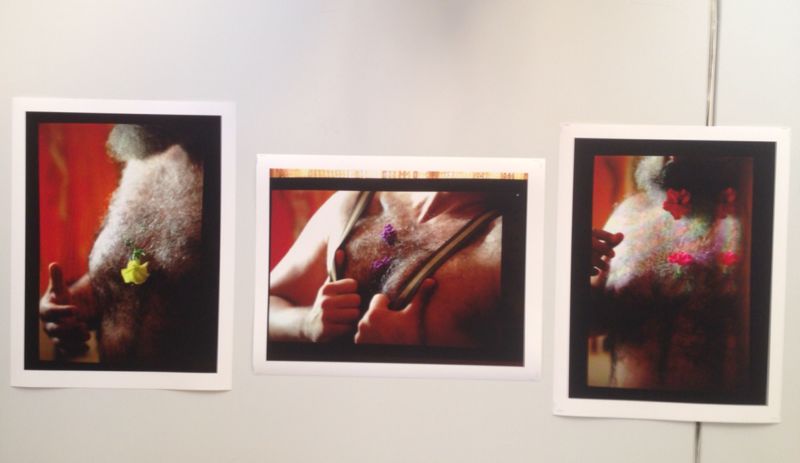 [Rokni and Ramin Haerizadeh, Triptych (2013). Image copyright the artists.]
[Rokni and Ramin Haerizadeh, Triptych (2013). Image copyright the artists.]
I strolled back and forth between these last three works, pausing to contemplate the beard cupping Monira Al Qadiri’s face—often a symbol of masculinity, authority, and piety in the Middle East, and of terror, fanaticism, and misogyny in the West. Faced with Al Qadiri’s bearded female visage, both of these interpretations lost their connotative power. What else, I thought, can men’s body hair “do”? Can it create a warm, nurturing bosom like the one depicted in the Haerizadeh brothers’ work? Can it facilitate moments of intimacy like in Fader’s performance?
The ways in which we can rethink and recontextualize this bodily feature, the multitude of alternative forms of being and acting it can perform, and the reinterpretations of masculinity it can engender, as Alzaid shows in this quantitatively limited but thematically vast exhibition, are endless. Uniquely positioned as an exhibition in a city composed of bodies and subjectivities cultivated in a plethora of sociocultural contexts, this exhibition worked to “unsettle,” as the curator puts it, “the viewer’s understanding of the world around them without dismantling it outright.”
![[Rokni and Ramin Haerizadeh \"Recovering\" (2013). Image copyright the artists.]](https://kms.jadaliyya.com/Images/357x383xo/RokniandRaminHaerizadeh.jpg)












